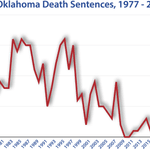
State & Federal
Oklahoma

History of the Death Penalty
Oklahoma had a question on the November 2016 ballot concerning “constitutionalizing” the state’s death penalty and removing the authority of the state courts to declare it to constitute cruel and unusual punishment or a violation of any provision of the state constitution. The measure passed, 66% — 34%. For more on the ballot question, see Ballotpedia, Oklahoma Death Penalty, State Question 776 (2016).
Oklahoma’s recent history with capital punishment has been characterized by botched executions. In April 2014, Oklahoma botched the execution of Clayton Lockett, failing for 51 minutes to set an intravenous execution line and then misplacing the line in Lockett’s groin, injecting the drugs into the surrounding subcutaneous tissue. With Lockett writhing on the gurney in a pool of blood, the execution was called off but 43 minutes after the drugs were first administered, he died. The state then called off the execution of Charles Warner also scheduled for that day.
Oklahoma then rescheduled Warner’s execution for January 2015. Media witnesses reported that Warner had said during his execution, “It feels like acid,” and “My body is on fire.” It was later discovered that the state had obtained and used an unauthorized drug, potassium acetate, as the third drug in carrying out Warner’s execution. The state’s execution protocol called for the use of potassium chloride.
The state was scheduled to execute Richard Glossip on September 30, 2015, but then-Governor Mary Fallin called off his execution at the last minute after being informed that the Oklahoma Department of Corrections (ODOC) had again received the wrong third drug in the state’s lethal-injection protocol. It was later revealed that the state had known for months before the aborted attempt to execute Glossip that it had used the same unauthorized drug to execute Warner.
After a grand jury investigation and a representation by state prosecutors in a federal lawsuit that they would not resume executions until legal issues surrounding Oklahoma’s execution protocol were resolved, the state resumed executions in October 2021. Reneging on its promise to the federal court, the state scheduled seven executions over a five month period between October 2021 and March 2022 even though a federal trial on the constitutionality of its three-drug midazolam-based protocol was scheduled for February 2022. On October 28, 2021, the state botched the execution of John Grant. Media eyewitnesses reported that Grant suffered repeated full-body convulsions and vomited over a nearly 15-minute period after the midazolam was administered. An ODOC spokesman issued a statement saying that the execution “was carried out in accordance with Oklahoma Department of Corrections’ protocols and without complication.” The state announced its intention to carry out the remaining executions without any changes in the protocol.
Timeline
1915 — Henry Bookman is the first person executed by electrocution in Oklahoma.
1930 — The first execution for a crime other than murder occurs when James Edward Forrest is sentenced to death for rape. Other crimes meriting the death penalty included offenses such as robbery with firearms and kidnapping.
1973 — Oklahoma reinstates the death penalty following Furman v. Georgia.
1988 — The Supreme Court rules that executions of offenders age fifteen and younger at the time of their crime is unconstitutional.
2013 — The Oklahoma Supreme Court suspends former prosecutor Robert Bradley Miller for misconduct in murder trials resulting in the release of two death row inmates.
2014 — Clayton Lockett dies of a heart attack approximately 40 minutes after the state began administering a new three-drug lethal injection protocol in a botched execution.
2014 — Various news organizations sue Oklahoma in a federal court lawsuit, attempting to give media witnesses a more complete view of executions than previously allowed.
2015 — The U.S. Supreme Court hears oral argument in Glossip v. Gross, a case challenging the use of midazolam in lethal injections following Clayton Lockett’s botched execution.
2015 — On June 29th, the Supreme Court held (5 – 4) in Glossip v. Gross that Oklahoma death row prisoners were unsuccessful in proving that the use of midazolam violates the 8th Amendment.
2015 — Oklahoma becomes first state to authorize execution by nitrogen hypoxia, should lethal injection be declared unconstitutional or unavailable.
2016 — Inaction on execution protocol ensures a two-year minimum hold on executions.
2018 — Oklahoma announces that the state plans to switch its method of execution from lethal injection to nitrogen gas asphyxiation.
2020 — Oklahoma announces plans to resume executions by returning to the same three-drug lethal injection cocktail responsible for a series of botches executions in 2014 and 2015.
2020 — The Supreme Court vacates the conviction of a Native American death row prisoner and affirms the sovereignty of the Muscogee (Creek) Nation over tribal lands, asserting that Oklahoma had no jurisdiction to try tribal members for serious offenses.
2021 — John Grant suffers pulmonary edema and intramuscular hemorrhaging throughout his execution, eventually aspirating on his vomit as a result of Oklahoma’s three-drug protocol. His autopsy indicates a swift build-up of fluid in the lungs that creates a feeling of suffocation or drowning that experts have likened to waterboarding.
2023 — Oklahoma Court upholds Richard Glossip’s conviction and parole board denies clemency.
2023 — Oklahoma House Judiciary Criminal Committee met to discuss ongoing concerns regarding the state’s capital punishment system and the possibility of recommending a moratorium on executions.
Notable Cases
In Thompson v. Oklahoma (1988), the U.S. Supreme Court ruled that executions of offenders age fifteen and younger at the time of their crimes are unconstitutional.
Notable Exonerations
Curtis McCarty was released in May 2007 after District Court Judge Twyla Mason Gray ordered that the charges against him be dismissed. McCarty had spent the last 22 years behind bars for the murder of a police officer’s daughter in 1982. Judge Gray ruled that the case against McCarty was tainted by the questionable testimony of former police chemist Joyce Gilchrist, who gave improper expert testimony about semen and hair evidence during McCarty’s trial. Gilchrist falsely testified that hairs and other biological evidence showed that McCarty could have been the killer. In Gilchrist’s original notes, she said that hairs from the crime scene did not match McCarty. She then changed her notes to say the hairs did match him. When the defense requested retesting, the hairs were lost. A judge has said Gilchrist either destroyed or willfully lost the hairs. DNA testing in recent years has also shown that another person raped the victim.
Clifford Henry Bowen was incarcerated in the Oklahoma State Penitentiary under three death sentences for over five years before the U.S. Court of Appeals for the Tenth Circuit overturned his conviction in 1986. The Court held that prosecutors in the case failed to disclose information about another suspect, Lee Crowe, and that had the defense known of the Crowe materials, the result of the trial would probably have been different. Crowe resembled Bowen, had greater motive, no alibi, and habitually carried the same gun and unusual ammunition as the murder weapon. Bowen, on the other hand, maintained his innocence, provided twelve alibi witnesses to confirm that he was 300 miles from the crime scene just one hour prior to the crime, and could not be linked by any physical evidence to the crime.
Eight other death row inmates have also been exonerated in Oklahoma.
Notable Commutations/Clemencies
Governor Lee Cruce commuted every death sentence imposed during his administration (1911 – 1915).
Phillip Dewitt Smith’s death sentence was commuted in 2001 by Gov. Francis A. Keating due to doubts about Smith’s guilt.
Governor Brad Henry commuted the death sentence of Osvaldo Torres to life without parole on May 13, 2004. Henry said that it was “important to remember that the actual shooter in these horrific murders was also sentenced to death and faces execution.” Henry also stated that he “concluded that there is a possibility a significant miscarriage of justice occurred… specifically that the violation of his Vienna Convention rights contributed to trial counsel’s ineffectiveness, that the jury did not hear significant evidence, and that the result of the trial is unreliable.” Henry’s decision followed a recommendation for clemency by the Pardon and Parole Board and a stay granted by the Oklahoma Court of Criminal Appeals. The International Court of Justice had ruled that the Vienna Convention rights of Torres and 50 other Mexican nationals on America’s death rows were violated. Under the Vienna Convention, foreign citizens arrested in the United States are entitled to contact their consulate for assistance.
Following the recommendation of the Oklahoma Pardon and Parole Board, Gov. Brad Henry granted clemency to Kevin Young in 2008, commuting his death sentence to life in prison without the possibility of parole. The Board’s recommendation of clemency was based on several factors, including the disproportionality of the punishment, questionable witnesses, and a decision during the original trial to turn down a plea bargain that would have resulted in a life sentence.
In 2010, Governor Brad Henry commuted the sentence of Richard Tandy Smith to life without the possibility of parole as recommended by the State Pardon and Parole Board. Life without parole was not available at the time of Smith’s sentencing. The governor believed life without parole would be the more appropriate sentence.
History of Misconduct in Oklahoma County
Five death-row prisoners wrongfully convicted In Oklahoma County in the 1980s and 1990s during the administration of former District Attorney “Cowboy” Bob Macy have been exonerated — the fourth most of any county in the U.S. Macy sent 54 people to death row during a 21-year tenure as District Attorney that was marked by prosecutorial misconduct.
23 of Macy’s capital convictions relied heavily on the testimony of disgraced police chemist Joyce Gilchrist, who an FBI investigation in 2001 concluded had offered testimony “that went beyond the acceptable limits of science.” An internal police investigation found that evidence in many of Gilchrist’s major cases was missing, along with three years of her blood analysis files. In the case of Curtis McCarty, Gilchrist falsely testified that hairs found at the crime scene matched McCarty’s and that his blood type matched the semen found on the victim’s body. A later investigation revealed that Gilchrist had altered her notes to implicate McCarty and that the hairs she had tested were missing. McCarty was exonerated in 2007 after independent DNA testing excluded him as a suspect. Almost half of the 23 people who were sentenced to death in trials in which Gilchrist testified were executed before their cases could be reviewed.
Current Oklahoma County death-row prisoners Julius Jones and Richard Glossip, also prosecuted during the Macy administration, face execution despite strong evidence of innocence. Glossip was sentenced to death for the 1996 murder of motel operator Barry Van Treese. No physical evidence linked Glossip to the murder, and the only evidence implicating him came from the multiple conflicting stories of the actual killer, Justin Sneed, a 19-year-old methamphetamine addict who was spared the death penalty in exchange for testifying that Glossip had offered to pay him to kill Van Treese. Jones, who has twice received recommendations for clemency by the Oklahoma Board of Pardon and Parole based on doubts as to his guilt, faces a November 18, 2021 execution date. He alleges that a combination of racial bias, poor representation, and false informant testimony led to him being sentenced to death for a crime he did not commit.
Other Interesting Facts
In the modern era (since 1976), Oklahoma has the highest number of executions per capita.
Oklahoma was the first state and the first jurisdiction in the world to adopt lethal injection as its method of execution in 1977. On December 16, 2010, Oklahoma became the first American state to use pentobarbital in the execution of John David Duty.
In 2015, Oklahoma became the first state to authorize execution by nitrogen hypoxia, although it has yet to develop a protocol for carrying out gas executions.

Resources

Oklahoma Execution Totals Since 1976
News & Developments
News
Jul 17, 2025
Oklahoma Attorney General Accused in New Court Filings of Reneging on Plea Agreement in Richard Glossip’s Case

Oklahoma Attorney General Gentner Drummond is facing accusations that he broke a written agreement that would have freed former death row prisoner Richard Glossip from prison more than two years ago, according to court documents filed in mid-July 2025. The revelation centers on email exchanges from April 2023, where AG Drummond, in a thread with Don Knight, counsel for Mr. Glossip, agreed to a plea deal that would have resulted in Mr. Glossip’s immediate release after more…
Read MoreNews
Jun 10, 2025
Oklahoma Attorney General Will Not Seek Death Penalty Against Richard Glossip in Retrial
On June 9, 2025, Oklahoma Attorney General Gentner Drummond announced that his office will retry death row prisoner Richard Glossip but will not seek the death penalty. AG Drummond’s decision to retry Mr. Glossip follows the February 2025 United States Supreme Court ruling in Glossip v. Oklahoma, in which the high court threw out Mr. Glossip’s 2004 conviction and ordered a new trial because prosecutors allowed a key witness to lie in court and withheld crucial information…
Read MoreNews
Jun 04, 2025
2025 Roundup of Death Penalty Related Legislation
More than one hundred bills have been introduced this year in 34 states and in Congress to expand and limit use of the death penalty, abolish and reinstate the death penalty, modify execution protocols and secret the information about them, and alter aspects of capital trials. Thus far, nine bills in five states have been enacted, with Florida enacting the most legislation. Of the bills that have been signed into law, three modify execution protocols; two expand…
Read MoreNews
Mar 24, 2025
Four Executions in Three Days Spotlight Constitutional Concerns About Death Penalty
In a three-day span from March 18 to March 20, four men were executed in four different states. Two of the men put to death, in Louisiana and Arizona, were the first executed in their state in years. While the close timing of the executions resulted from independent state-level decisions and individualized legal developments rather than any coordinated national effort, all four executions raised serious constitutional concerns. ### March 18: Jessie Hoffman (LA) On…
Read MoreNews
Mar 11, 2025
Former Chair of Oklahoma Board of Pardons and Parole Speaks Out Against the Death Penalty as Pending Moratorium Bills Gain Support in Legislature
Adam Luck (pictured), the former Chairman of Oklahoma’s Board of Pardons and Parole and former member of the Oklahoma Board of Corrections, is now speaking out against the death penalty in Oklahoma. Explaining his change of heart, Mr. Luck cites to his first-hand experience with flaws in Oklahoma’s capital punishment system, including botched executions, and his deep Christian faith.“Having the unique experience of voting on the life of another human being forced me to…
Read More

